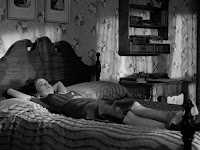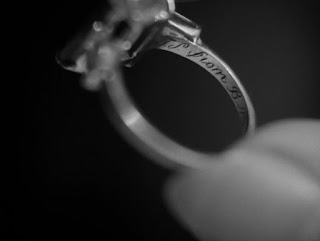Classical Narration Par Excellence : Reading 'Shadow of a Doubt'
Alfred Hitchcock, in his famous book-length conversation with Francois Truffaut, said about Shadow of a Doubt (1943) -
"I wouldn't say that Shadow of a Doubt is my favorite picture, if I've given that impression, it's probably because I feel that there is something that our friends, the plausibles and logicians, cannot complain about; (even) the psychologists as well"
Even if we do not want to take the director's words authoritatively, it is undoubtedly the fact that Shadow of a Doubt is one of the few films of Hitchcock's oeuvre (even, to some extent, Classical Hollywood Cinema) which is like a perfectly cut diamond; where light reflects is a perfect and equally proportional manner. We can call the film classical par excellence, where balance and proportion, harmony and synthesis creates a formal system that calls for an exclusive praise. Shadow of a Doubt is pivotal both in Hitchcock's and Hollywood's output which set the benchmarks for exceptional films yet to come in late 40s and 50s.
Raymond Bellour, in his discussion about Hitchcock's films proposed a narrative model for reading Hitchcockian system -
"In the Hitchcockian fable, investigations conform to two major modalities, complementary and interchangeable, in which the relationships of identification are established by the position of knowledge that Hitchcock reserves for himself (and thus for the spectator as well) as opposed to the various subjects (supports) of fiction. The inquiry represents, first of all, an ideal testing ground for the hero (or the heroin as mirror image, or the coupl-as-subject), who, constrained by chance and necessity, learns to acknowledge a certain truth about his (her) own desire after a dramaturgy of violence based on the search for the secret"
Now, whether or not this model is applicable for any given Hitchcock film is a matter of debate, but Shadow of a Doubt fits perfectly within this narrative logic. Here, we find that the major knowledge of investigation (that Uncle Charlie is the merry widow murderer) is reserved for the spectator as opposed to the various subject within the story (like the detective Graham, the niece charlie, or other member of the Newton family). And, the heroin niece Charlie takes up the primary roll of investigator which gives her the acknowledgement of a certain truth 'about his (her) own desire after a dramaturgy of violence based on the search for the secret'.
Apart from Bellour's proposal, we understand that this film fits the causal structure theorized by David Bordwell. Here we can find the perfect cause-effect relationship governing throughout the film - because Uncle Charlie is the pathological murdered and chased by the police, he has to find a remote shelter, so he wants to join the Newton family; because the niece is so much upset about the mundane life she need Uncle Charlie - these two forces join together and we have the series of events unfolding in the causal manner.
Studying the classical causal narrative, we find that this type of narrative gives us certain hints and clues which acts like requisite fingerpost with respect to the narrative journey. We found scenes and dialogues which works in a dynamic fashion, giving us not only a causal relationship with the previous scene, but also working in a double function, which can only be understood after the ending. Kristin Thompson, in his co-authored book with Bordwell and Steiger wrote about the same thing of 'the classical cinema's tendency to direct audience attention forward by frequent 'priming' of future events in the plot.' Especially in these scenes, we find sequences and dialogues which turns sarcastic and ironical after the film ends.
 |
| Doubling misen-en-scene - Uncle Charlie |
 |
| Doubling misen-en-scene - Niece Charlie |
Here, in this sequence, we find Uncle Charlie at the Newton family, giving gifts at the dinner table. After distributing all the gifts which he bought, the niece reacts quite odd and comes to another room saying she needs nothing material, thus creating an exclusive space for dialogue between two of them.
Now, we watch the explanation of her neurotic response against accepting gifts in the next shot where she explains that coming of the uncle is the greatest gift to her at that very moment. She also remarks that her mother named her after her uncle carries a special connotation, as not only her mother, but she herself also thinks that they are both alike.
Now, this gives us a crucial hint, because not only this neurotic connection are joined against their identical name, Hitchcock gives us an important information at the start of the picture about the telepathy - their mind can think the same thing at the same time. As the narrative journey creates tension at the first half of the picture - these words would become dangerous for the uncle towards the progression, we get the hints here.
As we talked about the narrative fingerposts, we get them here. The precise fact that Uncle Charlie is hiding things from everyone are underlined here in an oblique manner. The sudden change of expression in his face magnifies the ironic nature of the dialogues. What is essentially beautiful and wonderful to the niece is terrible and threatening to the Uncle. Not only in the material level of a particular crime committed by a character in this story, this whole dichotomy is crucial to understand the philosophical thesis of the film. Where Uncle Charlie thinks of the world as crude and ruthless, (to use the exact words, 'Do you know the world is a foul sty? Do you know if you ripped the fronts off houses, you'd found swines?), the niece thinks of it differently. At the very end of the film, we find these dialectic explicitly stated where the girl tales her boyfriend about her uncle's image of the foul world. As she stated and denied the view, we hear in soundtrack the admiration of her late uncle precisely in these words - 'the beauty of their souls, the sweetness of their characters'. So, this whole dialectic principle is subtly suggested here through dialogue and performance in this sequence.
Another key element is also introduced which will serve the central role to the girl's journey to find the truth about her uncle. Uncle Charlie gives her a emerald ring as the gift.
Now, almost immediately the ring's position in the narrative is explicitly uttered where the girl noticed the initials engraved their.
The soundtrack emphasizes the moment also by playing The Merry Widow Waltz precisely at this point and will'll learn that just after this sequence, the niece along with her mother started thinking about this tune in their head without identifying the actual one. Apart from that, this engraving helped the girl to find the name of the widow victim later in the newspaper.
We also have the repetition of the misen-en-scene later in the library with the famous Hitchcockian tracking shot from a close object to the long establishment. (Which is most famous in Notorious)
Extreme close shot of the ring taken later in the library also repeats the same misen-en-scene earlier seen in the sequence we are discussing. In the first sequence, what was simply an act of mistake (as suggested by Uncle Charlie) appears here as an act of heinous crime. Following the words of Kristin Thompson as quoted earlier, the film here connects the fingerposts together. Watching after the second close shot of the ring, the first shot appears to us layered and nuanced with possibilities of dynamic meanings.
Thus, most of the element through which the narrative of the film would progress are stated in this single tiny sequence with dialogue, misen-en-scene and performance. Through the argument, it can be stated that not just giving clues and hints, this sequence succeeded to act as a vantage point where both the story and its philosophical discourse are stated precisely in a nutshell. Hitchcock here created a marvellous example of classical construction which fits both Bellour's narrative principle and Bordwell's causally motivated storytelling together, which in turn proves our initial proposal - Shadow of a Doubt is like a perfectly shaped diamond where the light reflects in an impeccable way to declare the film as classical par excellence.
References:
Bordwell, D., Staiger, J., & Thompson, K. (1985) The Cassical Hollywood Cinema : Film style & mode of production to 1960. New York: Columbia University Press.
Bellour, Raymond (2000) The Analysis of Film; ed. Constance Penley: Indiana University Press.
Truffaut, Francois, Hitchcock, Alfred, (2017) Hitchcock: Faber & Faber
Related Article:
Shadow of Doubt, from the book, Rothman, William, Hitchcock, The Murderous Gaze
Related Article:
Shadow of Doubt, from the book, Rothman, William, Hitchcock, The Murderous Gaze













Comments
Post a Comment